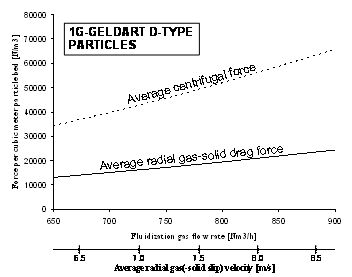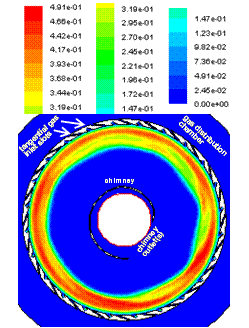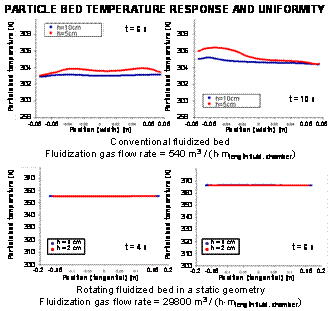597b Gas-Solid Heat Transfer In Rotating Fluidized Beds In a Static Geometry
Abstract:
Introduction and Concept
Gas-solid heat transfer in rotating fluidized beds in a static geometry (Figure 1(a)) is investigated theoretically and by means of computational fluid dynamics (CFD) simulations. In rotating fluidized beds in a static geometry, the fluidization gas flow rate influences both the centrifugal force and the radial gas-solid drag force in a similar way (Figure 1(b)). Hence, rotating fluidized beds in a static geometry can be operated over a very broad fluidization gas flow rate range, offering increased flexibility with respect to cooling or heating via the fluidization gas. Furthermore, dense operation at much higher fluidization gas velocities and, hence, gas-solid slip velocities than those in conventional fluidized beds is possible. The higher gas-solid slip velocities result in significantly higher gas-solid heat transfer coefficients. Intensification of the gas-solid heat transfer by one order of magnitude can be easily achieved.


(a) (b)
Figure 1: Rotating fluidized beds in a static geometry. (a) Schematic representation;
(b) Flexibility in the fluidization gas flow rate: experimentally measured behavior with 1G-Geldart D-type particles in a 24-cm diameter, 11.5 cm long fluidization chamber.
CFD Simulations of gas-solid heat transfer
2D CFD simulations of the response of the particle bed temperature to a step change in the fluidization gas temperature (Figures 2 and 3) confirm the theoretically predicted significantly higher allowable fluidization gas velocities and resulting gas-solid heat transfer coefficients in rotating fluidized beds in a static geometry compared to conventional fluidized beds. Furthermore, as a result of the rotational motion of the particle bed and the combined radial-tangential fluidization, the particle bed temperature is shown to be much more uniform in rotating fluidized beds in a static geometry than in conventional fluidized beds (Figure 3).




(a) (b) (c)
Figure 2: Snap-shot of the solids volume fraction. (a)-(b): Conventional fluidized bed at a fluidization gas flow rate of (a) 540 m3/(h×mlength fluid. chamber); (b) 1080 m3/(h×mlength fluid. chamber); (c) Rotating fluidized bed in a static geometry at a fluidization gas flow rate of 29800 m3/(h×mlength fluid. chamber).

Figure 3: Simulated response of the average particle bed temperature to a step change in the fluidization gas temperature from 300 K to 400 K at time t0 = 0 s. Comparison of a conventional fluidized bed and a rotating fluidized bed in a static geometry.
The combination of high fluidization gas velocities and high gas-solid heat transfer coefficients make rotating fluidized beds in a static geometry potentially interesting for carrying out fast and highly endothermic or exothermic reactions.